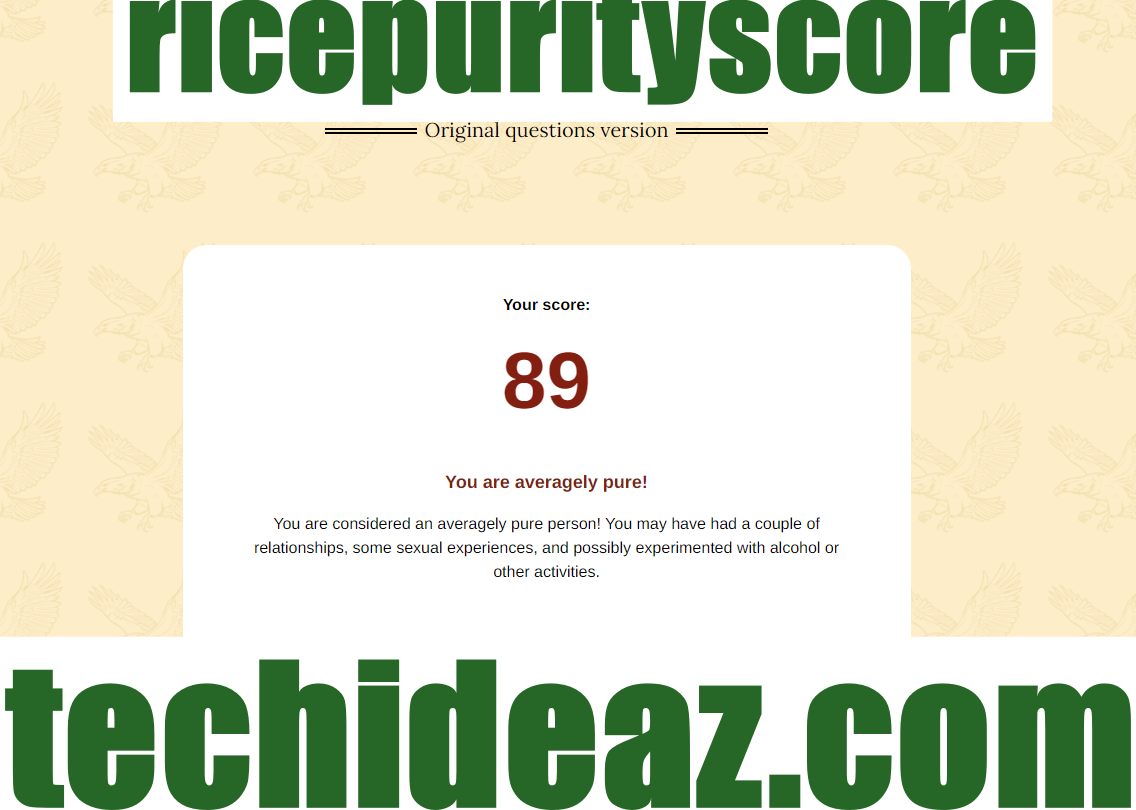Introduction to Rice Purity Score
The Rice Purity Score is a self-assessment test that has gained popularity, particularly among young adults, as a fun and insightful way to measure an individual’s experiences and behaviors. Originating from Rice University in Texas, this test has become a widely recognized, informal gauge of a person’s innocence or purity in certain aspects of life, particularly in relation to social behaviors, relationships, and experiences.
This test consists of 100 questions, which are typically answered by yes or no. The questions cover a variety of topics, such as romantic relationships, substance use, and illegal activities. The score is then calculated based on the number of questions the participant answers “no” to, and it serves as an indication of their personal experiences and exposure to certain activities.
The Rice Purity Test isn’t intended to judge or shame anyone, but rather to offer a lighthearted reflection on one’s personal history. Many people take the test as a rite of passage during their college years, while others use it as a conversation starter or a way to compare their experiences with peers. In this article, we will delve deeper into the Rice Purity Score, its history, significance, and how it’s used, along with some potential criticisms.
The Origin and Evolution of Rice Purity Score
The Rice Purity Score was created by students at Rice University in Houston, Texas, as a way to bond with their peers and create a fun, shared experience. The test was first introduced in the 1980s and has since gained widespread popularity across college campuses and online communities. Initially, it was used informally among students at Rice University, but over time, the test spread to universities across the United States and even beyond.
The Rice Purity Test was originally a printed document, and participants would mark their answers with a pen. However, as the internet grew and online communities blossomed, the test found a new home on websites, making it accessible to anyone around the world. Today, there are several variations of the test available on different platforms, but the basic structure remains the same: a list of 100 questions that cover a range of topics related to personal experiences and behaviors.
Though the Rice Purity Score was created in a university setting, it quickly became a part of popular culture, often used as a social tool or a way to explore one’s innocence and experiences. The questions themselves vary from lighthearted topics like “Have you ever danced in the rain?” to more serious matters such as “Have you ever been arrested?” This variety in questions is part of the test’s charm, as it invites participants to reflect on both positive and negative aspects of their lives.
Understanding the Structure of the Rice Purity Score
The Rice Purity Test consists of 100 questions, each designed to assess an individual’s experiences and actions across different areas of life. The questions are divided into categories such as relationships, substance use, sexual experiences, and illegal activities. The purpose of the test is not to shame or judge the participant but to provide insight into their personal experiences and level of exposure to certain aspects of life.
The test is usually taken by individuals in their late teens or early twenties, though people of all ages may take it for fun. When a person answers “yes” to a question, it means they have experienced or engaged in that particular activity. Conversely, when they answer “no,” it means they have not participated in that activity. The final score is based on how many “no” responses the participant gives, with a higher number of “no” answers indicating a “purer” score.
For example, questions related to substance use may ask if the participant has ever smoked cigarettes, tried alcohol, or used recreational drugs. Questions related to romantic and sexual experiences might inquire about kissing, dating, or engaging in intimate activities. Illegal activities might include questions like “Have you ever been caught stealing?” or “Have you ever been involved in a fight?”
How to Calculate the Rice Purity Score
The Rice Purity Score is calculated by counting the number of “no” answers given by the participant. For each “no” response, one point is added to the score. The total possible score is 100, which represents a perfect score with no experiences or activities from the list. The lower the score, the more experiences or activities the person has had.
For example, if a participant answers “no” to 80 out of the 100 questions, their Rice Purity Score would be 80. On the other hand, if someone answers “yes” to most of the questions, their score will be much lower, indicating a higher level of exposure to the experiences and behaviors listed in the test.
Many people enjoy comparing their scores with friends or others, sparking lighthearted discussions and revealing insights into each person’s life experiences. However, it’s important to keep in mind that the Rice Purity Score is not a definitive measure of morality or character. Rather, it serves as a fun and casual tool for reflection.
Why Do People Take the Rice Purity Test?
There are several reasons why people take the Rice Purity Test, each reflecting different motivations and interests. Below are some of the most common reasons:
- Self-Reflection: For many, taking the Rice Purity Test is an opportunity for self-reflection. It allows individuals to assess their life experiences, relationships, and behaviors in a structured way. Some people may even take the test periodically to track how their experiences change over time.
- Social Bonding: The test is often used as a conversation starter or icebreaker in social settings, especially among young adults and college students. It can be a fun and lighthearted way to bond with friends, make new acquaintances, and discover shared experiences.
- Curiosity: Many people take the Rice Purity Test out of curiosity to see how their experiences compare to others. The test has become somewhat of a rite of passage in some circles, with people eager to compare scores and discuss their answers.
- Fun and Entertainment: Ultimately, the Rice Purity Test is a fun and harmless activity. It’s not meant to be taken too seriously, and many people take it simply for entertainment. The lighthearted nature of the test, along with its playful questions, makes it an enjoyable experience for participants.
The Significance and Impact of Rice Purity Score
While the Rice Purity Score is often seen as a fun and harmless activity, its significance can vary depending on the context in which it’s taken. For some individuals, it may serve as a form of self-discovery, offering insight into their own values and experiences. For others, it may simply be a social tool for bonding and conversation.
The test’s impact is particularly noticeable in the college and university setting, where students often use it as a way to explore their boundaries, connect with others, and navigate the complexities of young adulthood. The Rice Purity Score can serve as a reflection of one’s personal journey and growth, helping individuals understand how they have evolved over time.
However, there are criticisms of the Rice Purity Test as well. Some argue that the test can reinforce societal norms and pressures around issues such as sexuality, substance use, and morality. The test’s emphasis on certain activities may create a sense of judgment, even if it is not intended to be taken seriously. As with any self-assessment tool, the Rice Purity Score should be viewed with a critical eye and understood in its appropriate context.
Conclusion: Embracing the Rice Purity Score with a Healthy Perspective
In conclusion, the Rice Purity Score serves as a fun and lighthearted way to explore one’s personal experiences and connect with others. It’s important to remember that the test is not a measure of morality, nor should it be used as a tool for self-judgment. Instead, the Rice Purity Score is an opportunity for self-reflection, social bonding, and entertainment.
Whether you’re curious about your own experiences or looking for a fun way to connect with friends, the Rice Purity Test offers a unique and engaging way to explore the complexities of life. However, it’s crucial to approach the test with a healthy perspective, recognizing that everyone’s journey is different and that the Rice Purity Score is just one of many ways to reflect on personal experiences.
Remember that the Rice Purity Test is not a reflection of your worth or character. It’s simply a fun activity that provides a snapshot of your experiences at a given moment in time. Embrace it for what it is, and enjoy the process of exploring your own personal history in a lighthearted and non-judgmental way.
Frequently Asked Questions (FAQs)
Q1: What is the Rice Purity Test? The Rice Purity Test is a self-assessment quiz consisting of 100 questions that assess a person’s experiences and behaviors in areas like relationships, substance use, and illegal activities. It is used for self-reflection and social bonding.
Q2: How is the Rice Purity Score calculated? The Rice Purity Score is calculated based on how many questions a person answers “no” to. Each “no” response adds a point to the score, and the total score can range from 0 to 100, with 100 being the highest.
Q3: What is the purpose of the Rice Purity Test? The purpose of the **Rice Purity
Test** is to provide individuals with a fun and lighthearted way to reflect on their personal experiences. It is not meant to judge or shame anyone but rather to encourage self-reflection and social interaction.
Q4: Is the Rice Purity Test a reliable measure of someone’s character? No, the Rice Purity Test is not a reliable measure of someone’s character or morality. It is a casual and fun tool for reflecting on personal experiences, but it should not be used to judge anyone.
Q5: Can I retake the Rice Purity Test? Yes, you can retake the Rice Purity Test as often as you like. Many people retake it periodically to see how their experiences have changed over time.
Q6: Are there any criticisms of the Rice Purity Test? Some criticisms of the Rice Purity Test suggest that it may reinforce societal pressures and norms around issues such as sexuality and substance use. It is important to approach the test with a healthy perspective and not take it too seriously.
This article provides a comprehensive overview of the Rice Purity Score, its significance, and its impact. The test is a lighthearted and casual tool for self-reflection and social interaction, but should be understood in its appropriate context.
Also Read This: The Ultimate Guide to Rice Purity Score: Understanding and Exploring the Test










